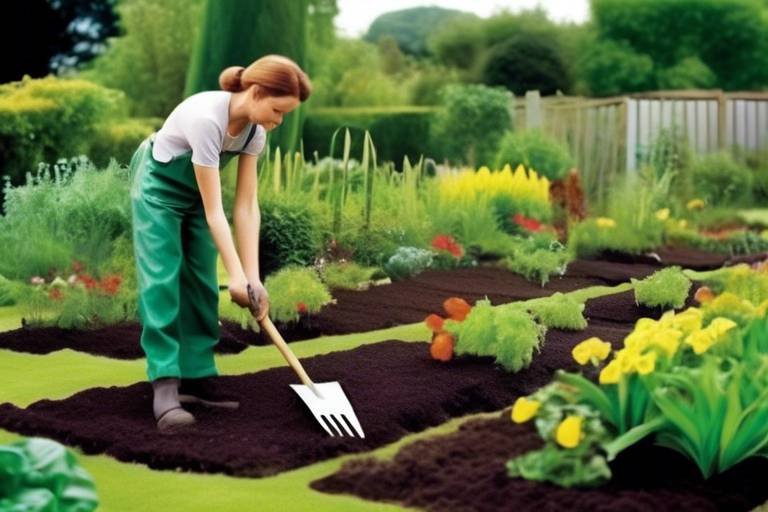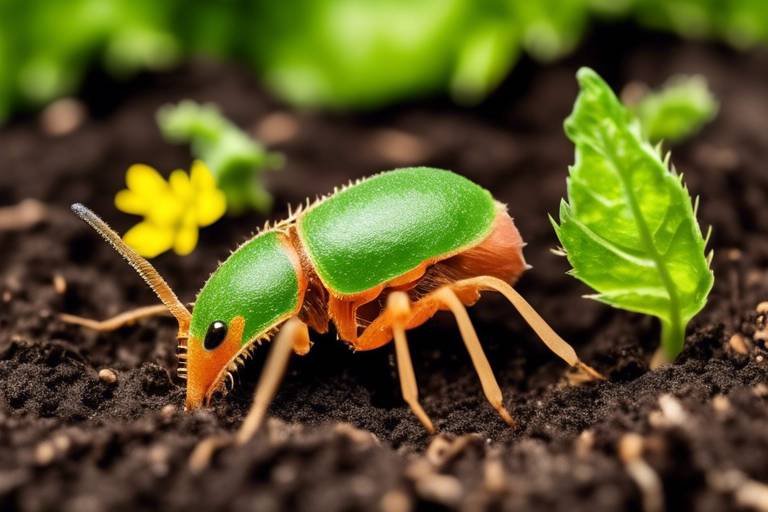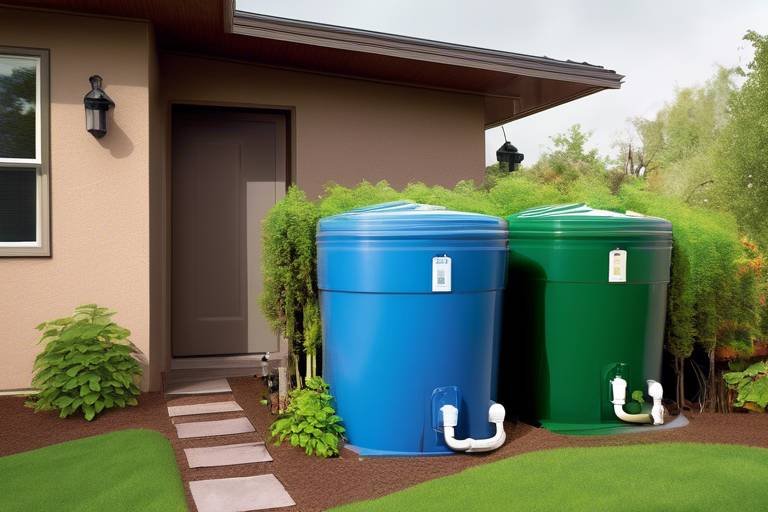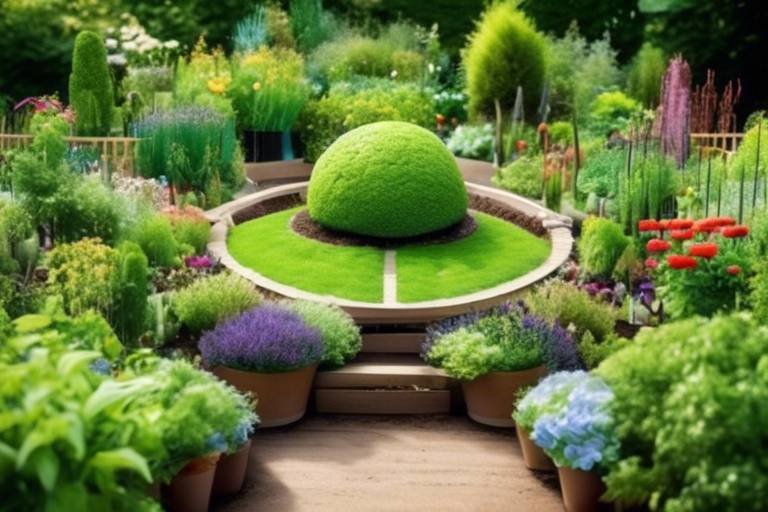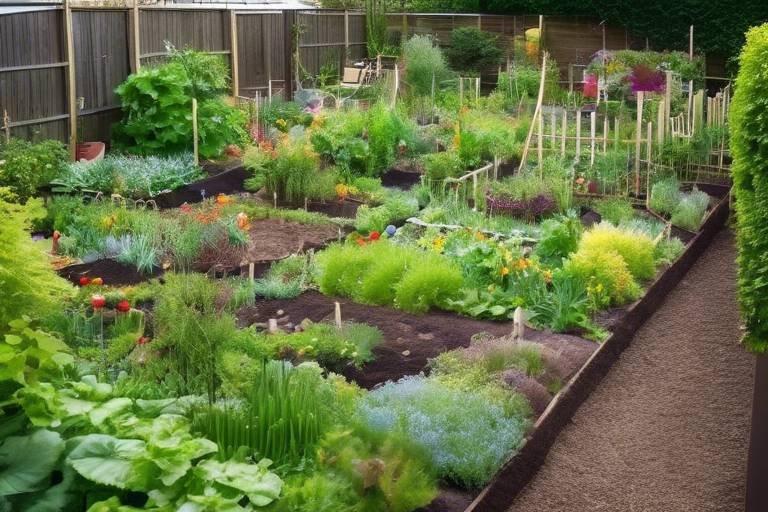How to Use Vertical Space in an Eco-Friendly Garden
Are you tired of a cramped garden with limited space? Do you dream of a flourishing green oasis that not only looks beautiful but also contributes to the environment? If so, you're in the right place! This article explores innovative strategies for maximizing vertical space in your garden while promoting sustainability. Discover tips for creating a flourishing green environment that benefits both plants and the planet.
Vertical gardening involves growing plants upwards rather than outwards. Imagine your garden as a canvas, where you can paint with greenery and color by utilizing every inch of space available. This technique not only saves space but also enhances air circulation and sunlight exposure, making it an ideal choice for eco-friendly gardening enthusiasts. By going vertical, you can create a haven for plants while minimizing your environmental footprint. Think of it as building a green skyscraper, where each floor is dedicated to different plants that thrive in their unique vertical habitat.
Selecting suitable plants for vertical gardening is crucial. You want to opt for species that thrive in vertical setups, such as climbing vines, herbs, and flowering plants, to create a vibrant, sustainable garden. When choosing plants, consider their growth habits and environmental needs. Some plants are natural climbers, while others may need a little help to reach their full potential. Here's a quick breakdown of some excellent choices for your vertical paradise:
- Climbing Vines: Perfect for creating lush greenery.
- Herbs: Great for cooking and saving space.
- Flowering Plants: Add color and attract pollinators.
Climbing vines are excellent for vertical gardens, providing lush greenery and beautiful flowers. Popular options include clematis, morning glories, and jasmine, which can transform any vertical structure into a stunning focal point. Imagine walking through your garden and being greeted by the sweet scent of jasmine or the vibrant hues of morning glories climbing up a trellis. Not only do these vines add aesthetic appeal, but they also create habitats for beneficial insects.
Herbs like basil, mint, and thyme can thrive in vertical gardens. They not only save space but also provide fresh ingredients for cooking, enhancing the garden's functionality and sustainability. Picture stepping into your kitchen and snipping fresh basil for your pasta or mint for your tea, all while knowing that you’ve nurtured these plants in an eco-friendly manner.
Integrating flowering plants such as nasturtiums and sweet peas into vertical gardens adds color and attracts pollinators. These plants contribute to biodiversity while creating a visually appealing environment. By planting a variety of flowers, you can create a vibrant tapestry that not only pleases the eye but also supports the ecosystem. Just think of your garden as a stage, where each plant plays a role in the grand performance of nature.
Creating a sturdy structure is essential for supporting your vertical garden. Options include trellises, wall planters, and repurposed materials that align with eco-friendly practices. Consider using recycled wood or old pallets to construct your garden framework. Not only does this reduce waste, but it also adds a rustic charm to your garden. You might even find that building your vertical garden becomes a fun DIY project that adds personal flair to your green space.
Proper watering and maintenance are vital for the success of a vertical garden. Techniques such as drip irrigation and self-watering systems can enhance efficiency while conserving water resources. Imagine being able to water your garden with minimal effort while ensuring that each plant receives just the right amount of moisture. This not only saves time but also contributes to a sustainable gardening practice.
Drip irrigation systems deliver water directly to the roots, minimizing waste and ensuring that each plant receives adequate moisture. This method is both sustainable and effective for vertical gardens. Think of it as a personal butler for your plants, providing them with a steady supply of water without the fuss.
Routine maintenance, including pruning and pest control, is essential for a thriving vertical garden. Implementing organic practices ensures a healthy ecosystem while reducing environmental impact. Regularly checking your plants for pests or diseases can save you a lot of trouble down the line. Just like any living thing, your garden needs attention and care to flourish.
Q: What are the best plants for vertical gardening?
A: Some of the best plants include climbing vines like clematis and morning glories, herbs such as basil and mint, and flowering plants like nasturtiums and sweet peas.
Q: How do I build a vertical garden structure?
A: You can use trellises, wall planters, or repurposed materials. Consider using recycled wood or pallets for a sustainable approach.
Q: What is the most efficient way to water a vertical garden?
A: Implementing a drip irrigation system is the most efficient way to ensure your plants receive adequate moisture without wasting water.

Understanding Vertical Gardening
This article explores innovative strategies for maximizing vertical space in your garden while promoting sustainability. Discover tips for creating a flourishing green environment that benefits both plants and the planet.
Vertical gardening is an innovative approach that encourages plants to grow upwards instead of outwards. Imagine transforming your limited garden space into a vertical paradise, where every inch counts! This technique is not just about saving space; it also promotes better air circulation and sunlight exposure, creating a healthier environment for your plants. Think of it like stacking books on a shelf; instead of spreading them out, you’re utilizing vertical space to maximize your collection. In urban settings where ground space is limited, vertical gardening can be a game-changer, allowing you to cultivate a diverse range of plants without needing a sprawling yard.
One of the beauties of vertical gardening is its versatility. You can use various structures to support your plants, from traditional trellises to creative repurposed materials like wooden pallets or old ladders. This not only adds an artistic touch to your garden but also aligns with eco-friendly practices by reducing waste. Imagine the satisfaction of growing your own vegetables, herbs, and flowers while contributing to a more sustainable planet!
Moreover, vertical gardens can enhance the aesthetic appeal of your home. They serve as living art installations that can beautify walls, fences, and balconies. By incorporating a variety of plants, you can create a stunning visual display that changes with the seasons. Not to mention, vertical gardens can also help to insulate your home, reducing energy costs by keeping it cooler in the summer and warmer in the winter.
In conclusion, understanding the principles of vertical gardening opens up a world of possibilities for eco-conscious gardeners. It’s not just a trend; it’s a lifestyle choice that promotes sustainability and creativity. So, why not take the plunge and start your vertical garden today? Your plants—and the planet—will thank you!
Selecting suitable plants for vertical gardening is crucial. Opt for species that thrive in vertical setups, such as climbing vines, herbs, and flowering plants, to create a vibrant, sustainable garden.
Climbing vines are excellent for vertical gardens, providing lush greenery and beautiful flowers. Popular options include clematis, morning glories, and jasmine, which can transform any vertical structure into a stunning focal point.
Herbs like basil, mint, and thyme can thrive in vertical gardens. They not only save space but also provide fresh ingredients for cooking, enhancing the garden's functionality and sustainability.
Integrating flowering plants such as nasturtiums and sweet peas into vertical gardens adds color and attracts pollinators. These plants contribute to biodiversity while creating a visually appealing environment.
Creating a sturdy structure is essential for supporting your vertical garden. Options include trellises, wall planters, and repurposed materials that align with eco-friendly practices.
Proper watering and maintenance are vital for the success of a vertical garden. Techniques such as drip irrigation and self-watering systems can enhance efficiency while conserving water resources.
Drip irrigation systems deliver water directly to the roots, minimizing waste and ensuring that each plant receives adequate moisture. This method is both sustainable and effective for vertical gardens.
Routine maintenance, including pruning and pest control, is essential for a thriving vertical garden. Implementing organic practices ensures a healthy ecosystem while reducing environmental impact.
Q: What is vertical gardening?
A: Vertical gardening is a method of growing plants upwards using structures like trellises, wall planters, or even repurposed materials, maximizing space and enhancing plant health.
Q: What types of plants are best for vertical gardens?
A: Ideal plants for vertical gardens include climbing vines, herbs, and flowering plants. Examples are clematis, basil, and nasturtiums.
Q: How do I maintain a vertical garden?
A: Regular maintenance involves watering, pruning, and pest control. Techniques such as drip irrigation can help optimize water usage.
Q: Can I grow vegetables in a vertical garden?
A: Absolutely! Many vegetables, such as tomatoes and cucumbers, can be successfully grown in vertical gardens.

Choosing the Right Plants
When it comes to vertical gardening, is like picking the perfect ingredients for a delicious recipe. You want to ensure that each plant not only thrives in an upward environment but also complements the overall aesthetic of your garden. Think of your vertical space as a canvas, and the plants as your vibrant colors. The right selection can turn a simple wall or trellis into a breathtaking masterpiece.
First and foremost, consider plants that naturally grow upwards. Climbing vines are a fantastic option, as they not only add height but also create a lush, green backdrop. Varieties like clematis, morning glories, and jasmine are popular choices that can transform any vertical structure into a stunning focal point. These plants are like nature's climbers, reaching for the sun while adding a touch of elegance to your garden.
But it’s not just about aesthetics; functionality plays a crucial role too. Imagine stepping into your garden and being greeted by the fresh aroma of herbs like basil, mint, and thyme. These herbs are perfect for vertical gardening because they thrive in small spaces and can be easily harvested for culinary delights. Not only do they save space, but they also enhance the sustainability of your garden by providing fresh ingredients right at your fingertips.
Flowering plants are another essential component of your vertical garden. Integrating species such as nasturtiums and sweet peas adds bursts of color that attract pollinators and beneficial insects. These plants are not just pretty faces; they contribute to biodiversity and create a more balanced ecosystem. Think of them as the party guests that bring life and energy to your garden gathering.
In summary, when selecting plants for your vertical garden, focus on:
- Climbing Vines: Look for plants that naturally climb, such as clematis and jasmine.
- Herbs: Choose herbs that are easy to maintain and useful in the kitchen.
- Flowering Plants: Include colorful blooms that attract pollinators.
By thoughtfully considering your plant choices, you can create a vertical garden that is not only visually stunning but also functional and beneficial for the environment. Remember, your garden is a reflection of your creativity and care, so make each plant choice count!
Q: What types of plants are best for a vertical garden?
A: Climbing vines, herbs, and flowering plants are excellent choices for vertical gardening. Look for species that thrive in vertical setups.
Q: How do I ensure my vertical garden gets enough sunlight?
A: Position your vertical garden in a spot that receives adequate sunlight throughout the day. You can also choose plants that tolerate partial shade if full sun is not available.
Q: Can I grow vegetables in a vertical garden?
A: Absolutely! Many vegetables, such as tomatoes and cucumbers, can be grown vertically. Just ensure they have the necessary support as they grow.

Climbing Vines for Vertical Growth
This article explores innovative strategies for maximizing vertical space in your garden while promoting sustainability. Discover tips for creating a flourishing green environment that benefits both plants and the planet.
Vertical gardening involves growing plants upwards rather than outwards. This technique not only saves space but also enhances air circulation and sunlight exposure, making it an ideal choice for eco-friendly gardening enthusiasts.
Selecting suitable plants for vertical gardening is crucial. Opt for species that thrive in vertical setups, such as climbing vines, herbs, and flowering plants, to create a vibrant, sustainable garden.
Climbing vines are not just a beautiful addition to any garden; they are a powerhouse when it comes to vertical gardening. These plants have a natural tendency to grow upwards, making them perfect for maximizing limited space. Imagine transforming a plain wall or fence into a breathtaking vertical landscape filled with lush greenery and vibrant blooms. Popular climbing vines like clematis, morning glories, and jasmine can create stunning focal points that not only enhance the aesthetic appeal of your garden but also promote biodiversity.
Each of these vines has unique characteristics that can complement your garden's design. For instance, clematis offers an array of colors and shapes, blooming at different times throughout the season, while morning glories provide quick coverage and a burst of color in the morning. Jasmine, on the other hand, not only adds beauty but also fills the air with its delightful fragrance, attracting beneficial pollinators like bees and butterflies.
When choosing climbing vines, consider the following:
- Growth Habit: Ensure the vine has a natural climbing ability, such as twining or clinging.
- Sunlight Requirements: Match the vine's sunlight needs with the location you have in mind.
- Climate Compatibility: Select species that thrive in your local climate to ensure successful growth.
By incorporating climbing vines into your vertical garden, you not only create a visually appealing environment but also contribute to a healthier ecosystem. These plants can provide shade, reduce heat, and even help purify the air, making your garden a sanctuary for both you and the local wildlife.
Herbs like basil, mint, and thyme can thrive in vertical gardens. They not only save space but also provide fresh ingredients for cooking, enhancing the garden's functionality and sustainability.
Integrating flowering plants such as nasturtiums and sweet peas into vertical gardens adds color and attracts pollinators. These plants contribute to biodiversity while creating a visually appealing environment.
Creating a sturdy structure is essential for supporting your vertical garden. Options include trellises, wall planters, and repurposed materials that align with eco-friendly practices.
Proper watering and maintenance are vital for the success of a vertical garden. Techniques such as drip irrigation and self-watering systems can enhance efficiency while conserving water resources.
Drip irrigation systems deliver water directly to the roots, minimizing waste and ensuring that each plant receives adequate moisture. This method is both sustainable and effective for vertical gardens.
Routine maintenance, including pruning and pest control, is essential for a thriving vertical garden. Implementing organic practices ensures a healthy ecosystem while reducing environmental impact.
Q: What are the best climbing vines for beginners?
A: Great options include morning glories and sweet peas, as they are easy to grow and maintain.
Q: Can I grow vegetables vertically?
A: Absolutely! Many vegetables like tomatoes and cucumbers can be grown vertically using trellises.
Q: How do I maintain my vertical garden?
A: Regular watering, pruning, and checking for pests will help keep your vertical garden healthy and thriving.

Herbs in Vertical Spaces
When it comes to creating an eco-friendly garden, herbs are some of the most rewarding plants you can grow, especially in vertical spaces. Not only do they save precious ground area, but they also offer a plethora of culinary and medicinal benefits. Imagine stepping into your kitchen and snipping fresh basil or mint from your vertical garden! It’s like having a mini grocery store right at your fingertips.
Vertical gardening allows you to maximize your herb-growing potential by utilizing walls, trellises, or even hanging pots. This method not only enhances the aesthetic appeal of your garden but also promotes better air circulation and light exposure for each plant. When herbs are grown vertically, they can bask in the sunlight without being overshadowed by larger plants. This is particularly important for sun-loving herbs like basil and oregano.
Here are some of the best herbs to consider for your vertical garden:
- Basil: A staple in many kitchens, basil thrives in warm weather and can grow quite tall if given the right support.
- Mint: This vigorous grower can be contained in a vertical setup, preventing it from taking over your garden.
- Thyme: A low-growing herb that does well in small spaces, thyme can cascade beautifully down a vertical planter.
- Chives: With their tall, slender leaves, chives add both flavor and visual interest to vertical arrangements.
By implementing vertical gardening techniques, you can create a sustainable herb garden that not only looks great but also yields fresh ingredients for your meals. Plus, the act of caring for your herbs can be incredibly therapeutic. Imagine the joy of watering your plants, watching them thrive, and then using them in your favorite dishes! It’s a win-win for your health and the environment.
Moreover, growing herbs vertically can also attract beneficial insects, such as bees and butterflies, which are essential for pollination. By creating a diverse ecosystem in your vertical garden, you contribute to the overall health of your local environment. So, whether you’re a seasoned gardener or just starting out, integrating herbs into your vertical space is a fantastic way to enhance your gardening experience.
Q: What are the benefits of growing herbs vertically?
A: Growing herbs vertically saves space, improves air circulation and sunlight exposure, and can enhance the aesthetic appeal of your garden. It also allows for easier access when harvesting.
Q: Can I grow herbs indoors using vertical gardening?
A: Absolutely! Many herbs thrive indoors, especially if you provide adequate light. Consider using a wall-mounted planter or a tiered shelf to maximize your indoor space.
Q: How often should I water my vertical herb garden?
A: The frequency of watering depends on the type of herbs and the climate. Generally, herbs prefer well-drained soil and should be watered when the top inch of soil feels dry. Drip irrigation systems can help maintain optimal moisture levels.

Flowering Plants to Consider
Integrating flowering plants into your vertical garden not only adds a splash of color but also plays a vital role in attracting pollinators such as bees and butterflies. These plants can transform your vertical space into a vibrant oasis, making it not just a garden but a thriving ecosystem. One of the most significant benefits of including flowering plants is their ability to enhance biodiversity, which is essential for a sustainable environment.
When choosing flowering plants for your vertical garden, consider varieties that are well-suited for upward growth. For instance, nasturtiums are an excellent choice; not only do they produce stunning, colorful blooms, but their leaves and flowers are also edible, adding a unique twist to your culinary adventures. Another fantastic option is the sweet pea, known for its delightful fragrance and charming flowers. These plants can climb trellises and walls effortlessly, creating a breathtaking display that draws the eye.
Additionally, you might want to explore plants like climbing roses or hummingbird vine, both of which can thrive in vertical setups and provide an enchanting visual appeal. Climbing roses, with their romantic blooms, can create a stunning backdrop in your garden, while hummingbird vines attract these beautiful creatures, further enriching your garden's ecosystem. To help you visualize the best options, here’s a quick comparison of some flowering plants you might consider:
| Plant Name | Growth Habit | Attracts | Edible Parts |
|---|---|---|---|
| Nasturtium | Climbing | Pollinators | Leaves and flowers |
| Sweet Pea | Climbing | Pollinators | No |
| Climbing Rose | Climbing | Pollinators | No |
| Hummingbird Vine | Climbing | Hummingbirds | No |
Incorporating these flowering plants into your vertical garden can create a stunning visual impact while also playing a crucial role in supporting local wildlife. By selecting a mix of colors, sizes, and growth habits, you can ensure that your vertical garden not only looks great but also thrives in a sustainable manner. Remember, a diverse garden is a healthy garden, so don’t hesitate to experiment with different species to find the perfect combination that suits your space and aesthetic.
- What are the benefits of vertical gardening? Vertical gardening saves space, improves air circulation, and enhances sunlight exposure for plants.
- Can I grow vegetables in a vertical garden? Yes, many vegetables can thrive in vertical gardens, including tomatoes, cucumbers, and peppers.
- How do I maintain a vertical garden? Regular watering, pruning, and pest control are essential for maintaining a healthy vertical garden.
- Are vertical gardens eco-friendly? Yes, vertical gardens promote sustainability by maximizing space and often utilizing recycled materials.
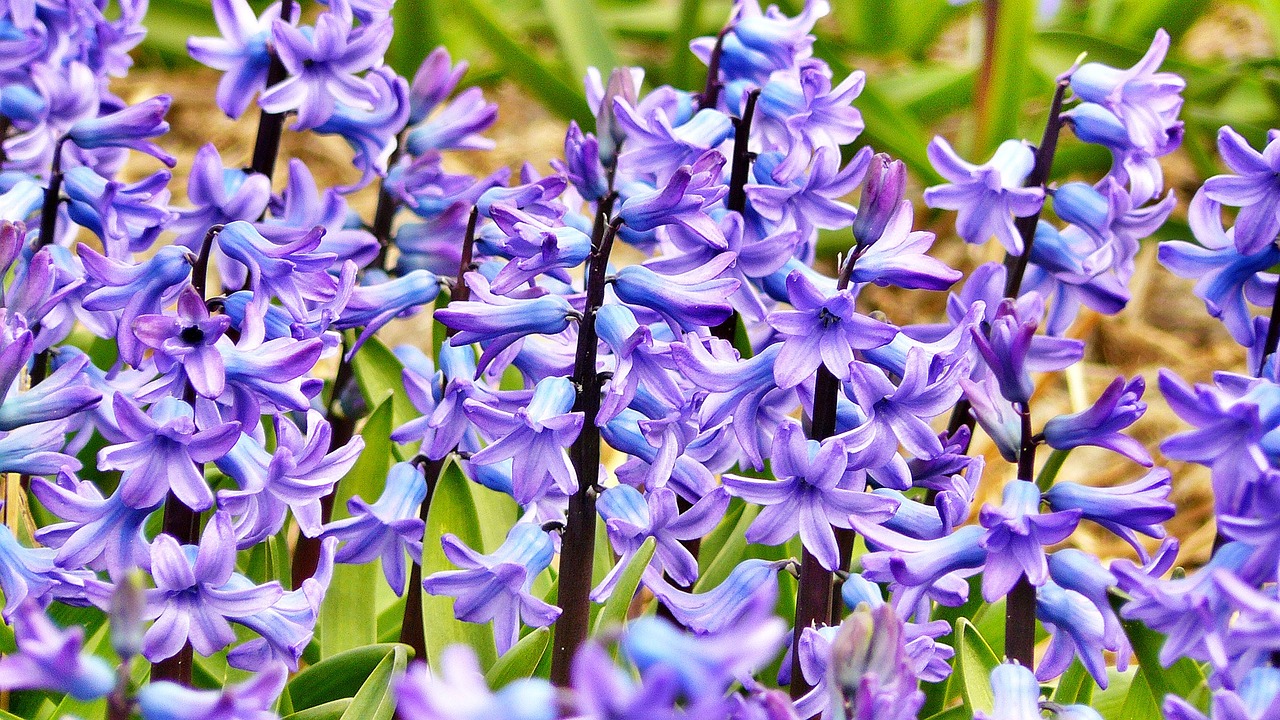
Building Your Vertical Garden Structure
When it comes to creating a vertical garden, the structure you build is just as important as the plants you choose. A well-designed structure not only supports your plants but also enhances the overall aesthetic of your garden. Think of it as the backbone of your green oasis—strong, supportive, and essential for growth. The beauty of vertical gardening is that you can get creative with materials and designs, making it both functional and visually appealing.
First off, consider the various options available for building your vertical garden. Trellises are a classic choice, providing a sturdy framework for climbing plants. You can purchase pre-made trellises or make your own using reclaimed wood or bamboo. Not only does this option save money, but it also aligns with eco-friendly practices. If you're feeling adventurous, you might even want to create a living wall using wall planters. These planters can be mounted directly onto your wall, creating a stunning display of greenery that breathes life into any space.
Another fantastic option is to repurpose materials you already have at home. Old pallets, for instance, can be transformed into a rustic vertical garden structure. Simply stand the pallet upright, fill it with soil, and plant your favorite herbs or flowers in the slats. This not only saves space but also gives a charming, quirky look to your garden. You could also use old ladders, crates, or even wine barrels to create unique vertical arrangements. The possibilities are endless, and the only limit is your imagination!
Don't forget about stability when building your structure. Ensure that it can withstand the weight of the plants as they grow. For heavier plants like tomatoes or cucumbers, a more robust design is necessary. You might consider using metal stakes or anchors to secure your structure in place, especially in windy areas. Remember, a well-built structure is crucial for the longevity of your vertical garden.
Finally, think about how your vertical garden will fit into your overall garden design. Will it be a focal point, or will it blend seamlessly with the rest of your plants? Consider the colors, textures, and heights of the plants you plan to use. By thoughtfully integrating your vertical garden structure into your existing space, you can create a harmonious and inviting environment that encourages growth and sustainability.
- What materials are best for building a vertical garden structure? You can use wood, metal, or even recycled materials like pallets and crates.
- How do I ensure my vertical garden structure is stable? Use sturdy materials and consider anchoring it to the ground if needed, especially for larger plants.
- Can I build a vertical garden indoors? Absolutely! Just ensure you have adequate light and support for the plants you choose.

Watering and Maintenance Tips
When it comes to nurturing your vertical garden, proper watering and maintenance are the keys to success. Just like a well-tuned orchestra, each element of your garden must work in harmony to create a thriving ecosystem. One of the most effective methods for watering your plants is through drip irrigation. This technique allows water to flow directly to the roots of your plants, ensuring they receive the moisture they need without wasting a drop. Imagine your plants sipping water like a refreshing drink on a hot day—this method minimizes evaporation and runoff, making it a sustainable choice.
To set up a drip irrigation system, you'll need a few essential components: tubing, emitters, and connectors. The beauty of this system lies in its simplicity; you can customize it to fit your garden’s unique layout. For instance, if you have a wall planter with herbs, you can easily arrange the tubing to deliver water precisely where it’s needed. Not only does this method conserve water, but it also promotes healthy growth, as plants receive consistent moisture without the risk of overwatering.
Aside from watering, regular maintenance is crucial for the health of your vertical garden. Think of it as giving your plants a spa day! Routine practices such as pruning and pest control will keep your garden looking its best. Pruning helps to remove dead or diseased leaves, allowing more sunlight to reach the healthy parts of the plant. Plus, it encourages new growth, which is essential for a vibrant garden. As for pest control, consider using organic methods such as neem oil or insecticidal soap. These options are effective and safe for the environment, ensuring that you maintain a healthy ecosystem.
Moreover, it's essential to keep an eye on the overall health of your plants. Look for signs of distress, such as yellowing leaves or wilting stems, which can indicate issues like nutrient deficiencies or improper watering. You can easily address these problems with a little research and some adjustments to your care routine. For instance, if your plants are looking a bit droopy, it might be time to check your watering schedule or consider adding a balanced organic fertilizer to boost their nutrient intake.
In summary, the success of your vertical garden hinges on a combination of effective watering techniques and diligent maintenance practices. By implementing a drip irrigation system and committing to regular upkeep, you'll create a flourishing green space that not only looks beautiful but also contributes to a sustainable environment.
- What is the best way to water a vertical garden?
The best way to water a vertical garden is through a drip irrigation system, which delivers water directly to the roots, minimizing waste and ensuring adequate moisture.
- How often should I water my vertical garden?
Watering frequency depends on the plant types and weather conditions. Generally, check the soil moisture regularly and water when the top inch of soil feels dry.
- What are some common pests in vertical gardens?
Common pests include aphids, spider mites, and whiteflies. Regular inspections and organic pest control methods can help keep them at bay.
- Can I use regular soil for my vertical garden?
While you can use regular soil, it's better to opt for a lightweight potting mix that provides good drainage and aeration for your plants.
- How do I ensure my vertical garden gets enough sunlight?
Position your vertical garden in an area that receives at least 6 hours of sunlight daily. Consider the sun's movement and adjust the placement accordingly.

Implementing Drip Irrigation
When it comes to nurturing a thriving vertical garden, efficient watering is key. That's where drip irrigation comes into play. This innovative system delivers water directly to the roots of your plants, ensuring that they receive just the right amount of moisture without waste. Imagine a gentle rain that only falls where it's needed most—this is the magic of drip irrigation!
One of the best parts about drip irrigation is its sustainability. Traditional watering methods, like sprinklers, can lead to a lot of water loss through evaporation or runoff. But with drip irrigation, the water is delivered slowly and precisely, allowing it to seep into the soil effectively. This means your plants are not only getting the hydration they crave but also reducing your overall water consumption. It's like having a personal water delivery service for your garden!
To set up a drip irrigation system in your vertical garden, you'll need a few essential components:
- Drip tubing: This is the main line that carries water to your plants.
- Emitters: These tiny devices release water at a controlled rate, ensuring that each plant gets the moisture it needs.
- Pressure regulator: This helps maintain the right pressure in the system, preventing damage to the emitters.
- Filter: A filter is crucial to keep debris from clogging your emitters, ensuring a smooth flow of water.
Once you've gathered your materials, you can begin the installation process. Start by laying out the drip tubing along the vertical structure, making sure it reaches all your plants. Next, attach the emitters at appropriate intervals based on the water needs of each plant. For instance, heavier feeders like tomatoes might require more frequent watering than herbs like thyme. After everything is in place, connect the system to your water source, and voilà! You now have a self-sustaining watering system that works even when you're not around.
Remember, regular maintenance is essential to keep your drip irrigation system functioning optimally. Check for clogs in the emitters, ensure the tubing is intact, and adjust the flow as needed based on the season or plant growth. A little attention goes a long way in keeping your vertical garden flourishing!

Regular Maintenance Practices
Maintaining a vertical garden is akin to nurturing a relationship; it requires consistent attention and care to flourish. Just like you wouldn’t let a friend go without a check-in, your plants need regular visits to ensure they are thriving. One of the most critical aspects of vertical garden maintenance is pruning. By trimming dead or overgrown branches, you not only encourage new growth but also allow for better air circulation. Think of it as giving your plants a breath of fresh air!
Another essential practice is pest control. Pests can wreak havoc on your garden if left unchecked. Regularly inspect your plants for signs of pests such as aphids or spider mites. If you spot any unwelcome guests, consider using organic pest control methods. For instance, introducing beneficial insects like ladybugs can help keep harmful pests at bay without harming the environment. Plus, it adds a bit of excitement to your garden ecosystem!
Watering is another crucial maintenance task that deserves your attention. Vertical gardens can dry out more quickly than traditional gardens due to their exposure to sunlight and wind. Implementing a self-watering system can significantly ease the burden of daily watering. These systems ensure that your plants receive the right amount of moisture without the risk of overwatering, which can lead to root rot. You might even consider using recycled materials to create your own self-watering planters, marrying sustainability with functionality.
Lastly, don’t forget about fertilization. Just like we need a balanced diet to thrive, your plants benefit from nutrients as well. Use organic fertilizers to provide your plants with the essential nutrients they need to grow strong and healthy. Regular feedings can boost your plants' growth and flowering, making your vertical garden a vibrant oasis. You can create a simple fertilization schedule, perhaps every four to six weeks, to keep things organized.
In summary, regular maintenance practices for a vertical garden encompass:
- Pruning: Encourages new growth and improves air circulation.
- Pest Control: Regular inspections and organic methods to manage pests.
- Watering: Implementing self-watering systems for efficiency.
- Fertilization: Using organic fertilizers to nourish your plants.
By dedicating time to these practices, you’ll ensure your vertical garden not only survives but thrives, creating a lush, eco-friendly space that you can be proud of.
1. How often should I prune my vertical garden?
Pruning should be done regularly, ideally every few weeks, to promote healthy growth and prevent overcrowding.
2. What are the best organic pest control methods?
Using beneficial insects like ladybugs, neem oil, or insecticidal soap can help manage pests without harming the environment.
3. How do I know if my plants need more water?
Check the soil moisture by sticking your finger about an inch deep into the soil. If it feels dry, it's time to water.
4. Can I use regular fertilizer for my vertical garden?
It's best to use organic fertilizers specifically designed for container gardening to avoid chemical buildup and promote healthy soil.
Frequently Asked Questions
- What is vertical gardening?
Vertical gardening is a technique that involves growing plants upwards instead of outwards. This method is perfect for maximizing limited space and enhances air circulation and sunlight exposure, making it a fantastic choice for eco-friendly gardening enthusiasts.
- What types of plants are best for vertical gardens?
When choosing plants for vertical gardens, opt for climbing vines, herbs, and flowering plants. Some popular choices include clematis, morning glories, basil, mint, nasturtiums, and sweet peas. These plants not only thrive in vertical setups but also contribute to a vibrant and sustainable garden.
- How do I build a vertical garden structure?
Building a sturdy structure for your vertical garden is essential. You can use trellises, wall planters, or even repurposed materials like pallets or crates. The key is to ensure that the structure can support the weight of the plants and soil while aligning with eco-friendly practices.
- What are some effective watering techniques for vertical gardens?
Drip irrigation systems are highly effective for vertical gardens as they deliver water directly to the roots, minimizing waste. Self-watering systems can also be beneficial, ensuring that your plants receive adequate moisture without overwatering.
- How can I maintain my vertical garden?
Regular maintenance is crucial for a thriving vertical garden. This includes routine pruning, pest control, and monitoring plant health. Implementing organic practices not only helps maintain a healthy ecosystem but also reduces your environmental impact.
- Can I grow food in a vertical garden?
Absolutely! Vertical gardens are a great way to grow food. Herbs like basil and mint thrive in vertical spaces, and you can also grow vegetables like tomatoes and peppers using vertical structures. This not only saves space but also provides fresh ingredients right from your garden.
- What are the benefits of vertical gardening?
Vertical gardening offers numerous benefits, including maximizing limited space, enhancing air circulation, and improving sunlight exposure. It also promotes biodiversity, attracts pollinators, and can contribute to a more sustainable gardening practice by using less water and reducing the need for pesticides.




